Pick a pumpkin


Lucas Sousa touches a bumpy Goblin pumpkin, one of the more popular varieties grown by R.A.M. Farms and sold at its Turlock pumpkin patch. He and his classmates were photographed at the patch last fall. Photo: © 2020 Lori Eanes
Sitting atop hay bales at the R.A.M. Farms pumpkin patch in Turlock, excited kindergarteners learned there is more to this squash than the color orange and using it to carve jack-o-lanterns.
"I want you to take your finger and, can you point to an orange pumpkin? How about a red pumpkin? How about yellow? How about a pumpkin that has more than one color? How about a pumpkin that is bumpy?" asked farmer Karen Macedo, who captivated students visiting last fall from Hilmar's Elim Elementary School.
"Pumpkins come in different sizes, shapes and a variety of colors and they can be bumpy or smooth, but they all have several things in common: hard outer shells, ridges, and a stem end and a flower end," she said.
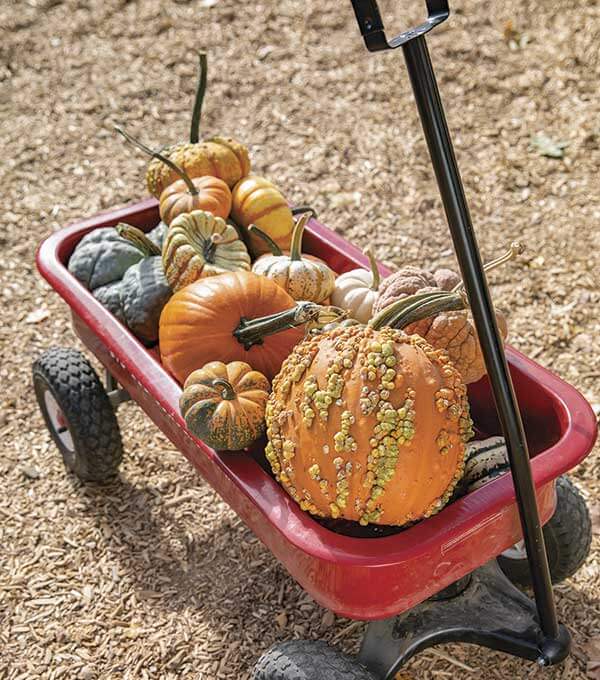
Red wagons make it easy for visitors to gather their favorites from among the 50 to 70 varieties of pumpkins, gourds and winter squash grown each year at R.A.M Farms. Photo: © 2020 Lori Eanes
No ordinary orb
Today's pumpkins are anything but ordinary. They can be multicolored with hues ranging from pastel pink, blue or green to bright red, orange or yellow. Specialty varieties are known for shape or color, such as the flatter, orange Cinderella pumpkin and the Goblin, which is orange with green warts.
California farmers grow nearly 5,000 acres of pumpkins each year and the state ranks among the top five in terms of national production. Illinois leads, with most of its crop used for canned pumpkin pie filling. The Golden State's pumpkins are primarily grown for decoration and jack-o-lanterns.
R.A.M. Farms is one of California's many pumpkin patches, where visitors flock each fall in search of the perfect pick. Operated by Ron and Karen Macedo since 2007, the farm grows between 50 and 70 varieties of pumpkins, gourds and winter squash on about 40 acres, and hosts 15,000 visitors and 2,400 schoolchildren annually.
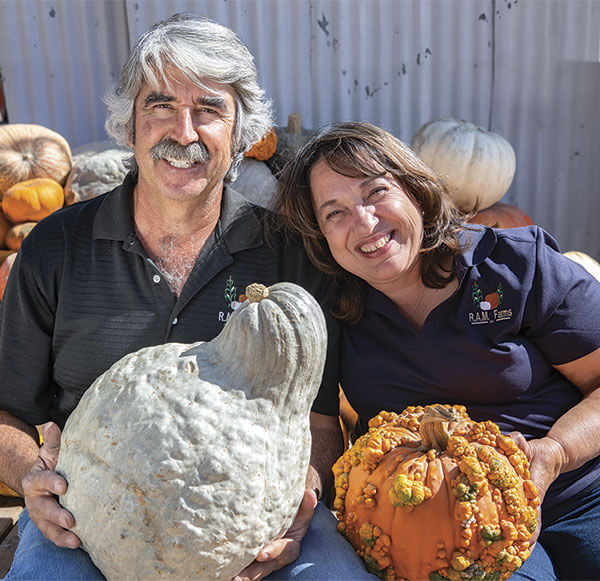
Farmer Ron Macedo is joined by his wife, Karen, who runs the pumpkin patch and leads educational tours. Photo: © 2020 Lori Eanes
Outdoor classroom
While Ron Macedo handles the farming, Karen Macedo, a former teacher, has a knack for engaging young students about growing pumpkins, from seed to patch.
"Most kids are amazed about all the different varieties of pumpkins we grow," she said. "They like to be outside and they love science. Kids naturally like to see how the world works."
Each year from mid-September through October, fall fun-seekers, families and schoolchildren visit R.A.M. Farms to take part in activities such as pumpkin bowling and an 18-acre corn maze, and also to choose their favorite pumpkin.
"I like the warty pumpkin because it feels bumpy," kindergartner Jade Caetano explained, while twin sister Ashton said she preferred the large, white pumpkin known as Snowball: "I'd take it home and paint it turquoise."
Meanwhile, Christian Andre, who is generally wild about dinosaurs, said, "I like the Cinderella pumpkin. It is the right size to make a Saurophaganax (dinosaur) head."
Emma Komos was more practical about her top choice: a small, orange pumpkin variety known as Field Trip.
"I like the stem to be a handle to carry it around," she said, adding she would like to decorate it with paint and stickers.
Their teacher, Lynette Rocha, brings her students each year and said, "R.A.M. Farms is a wonderful place to learn about farming pumpkins. As part of our science standards, we teach the students the life cycle of the pumpkin plant, and Karen is very good at identifying the many varieties of pumpkins."

Elim Elementary School teacher Lynette Rocha brings her kindergartners to R.A.M. Farms to have fun and learn about pumpkins. Photo: © 2020 Lori Eanes
The A, Bee, Cs of pumpkin farming
Karen Macedo explained to Rocha's class that pumpkins need water, sunlight, soil and bees: "As the bee pollinates, a little flower will start to grow and as the flower starts to grow, the pumpkin will then grow."
To ensure the pumpkins are ready by fall, R.A.M. Farms begins planting in mid-June. For pumpkins used for carving, the farm plants seeds directly in the field. For specialty pumpkins, seeds are started in six-pack containers and then transplanted into the field.
Ron Macedo, who also grows almonds, oats, silage corn and alfalfa, had grown pumpkins for many years before launching the pumpkin patch business in the early 2000s. That's when he put his last few pumpkins on the side of the road to sell directly to customers.
"People started buying them and we thought, 'We've got something here,'" he said. "That's how it all started and, over time, it has evolved into a destination."
Since then, the school tours have become a favorite part of the business.
"I enjoy providing the opportunity for schoolchildren to come here each year," he said. "They ask a lot of questions and end up having an appreciation for what we do in farming, plus moms and dads are just as curious."
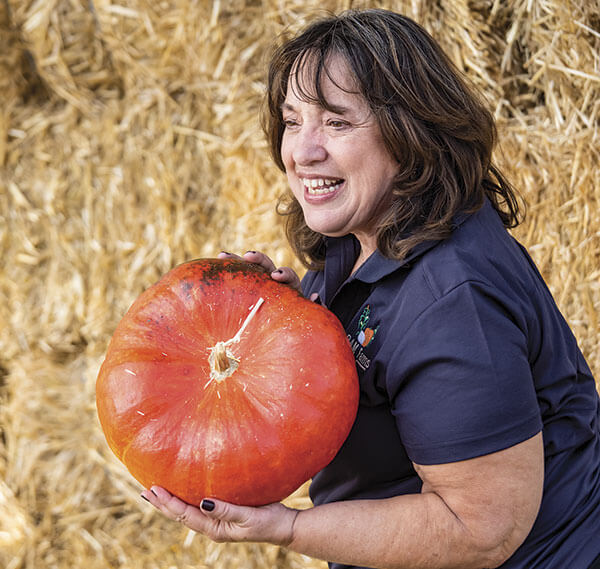
A former teacher, Karen Macedo enjoys telling visitors of all ages how pumpkins are grown, from seed to patch. Photo: © 2020 Lori Eanes
Pumpkins with a purpose
The Macedos are often asked the differences in pumpkin varieties. The Field Trip, for example, is a good pumpkin for carving, eating and decorating, Karen Macedo said. Other traditional carving varieties include Magic Wand and Gold Medal. A favorite for pie is Cinnamon Girl, and pink varieties such as Pink Porcelain Doll and Pink Princess are good for eating and décor.
"You can eat regular carving pumpkins, but the different varieties offer different flavors and textures," Karen Macedo said. "A regular carving pumpkin such as Magic Wand, which is the majority of our orange pumpkins and are between 25 and 80 pounds, have a thinner wall and are easier to carve. A smaller Sugar Pie pumpkin has better flavor. You can roast the seeds from any of the pumpkins we grow, but the best pumpkin seeds to roast are from the Kakai, because there is no outside hull."
She described the Fairytale, a dark mahogany orange, as great for décor and also to eat. The popular Cinderella is more red and also good to eat, whereas white varieties—including Baby Boo tiny pumpkins, midsized Snowball and Lumina, and the larger Polar Bear—make striking decorations.
Other varieties she prefers for eating include Festival, which is orange, yellow and green; Long Island Cheese, an American heirloom that is brownish and somewhat flat; and the green Kabocha, which features a sweet orange flesh.
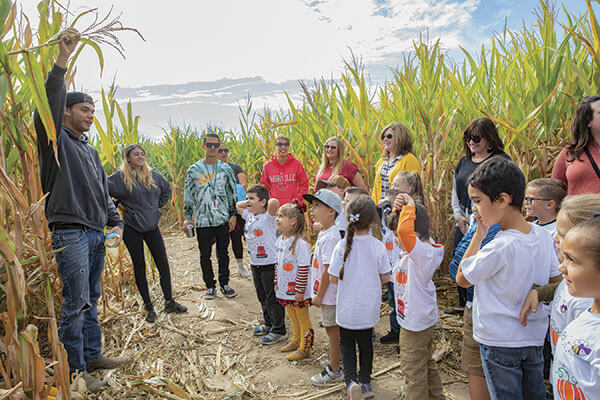
Farm employees Daelyn Dow and Celeste Vega tell students about the corn maze before inviting them in. Photo: © 2020 Lori Eanes
'The Happiest Pumpkins on Earth'
In addition to direct sales through its pumpkin patch, R.A.M. Farms is home to "the Happiest Pumpkins on Earth"—because its pumpkins and other gourds and winter squash are shipped to a Southern California theme park and various Northern California venues for ornamental purposes. The farm also sells orange pumpkins for carving to supermarkets, warehouse stores and garden centers.
Because outdoor pumpkin patches are classified as produce stands, visitors to R.A.M. Farms this year must follow COVID-19 safety guidelines, such as wearing masks, practicing social distancing and touching only the produce they intend to purchase. Karen Macedo said she is also considering delivering pumpkins to schools this year or creating a video to virtually teach children about how pumpkins grow.
"The pumpkin patch could be more of a draw this year because it is an outside destination," she said. "People really enjoy having a place to bring their families or for date night. It's something for the community to look forward to."
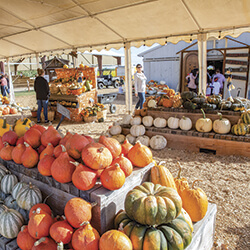
Photo: © 2020 Lori Eanes
Fun facts about pumpkins
Planning a trip to a pumpkin patch this season? Be sure to call ahead to confirm whether your favorite spot is open, and under what rules. Here are some pumpkin facts to help you make the most of your visit.
- Pumpkins are a type of squash, indigenous to North America and cultivated since at least 7,500 BCE.
- Gourds are grown for their hard, outer rind, whereas pumpkins are harvested for their outer shell and edible flesh.
- Pumpkins, squash, gourds and melons are part of the Cucurbitaceae family. They can be bred with one another, resulting in different varieties that vary in shape, color and texture.
- Pumpkins are a common feature for the fall holidays of Sukkot, Halloween and Thanksgiving, when people use them for decorating, cooking and carving.
- Miniature pumpkins weigh less than 1 pound and are used for decorative purposes. Pie pumpkins usually weigh between 5 and 10 pounds; jack-o-lanterns and processing pumpkins are 10 to 25 pounds. Pumpkins that exceed 25 pounds are known as giant and some can grow to more than 1,000 pounds.
- Pumpkins are rich in vitamins A and C, benefitting vision, skin and the immune system. Pumpkin seeds are a source of zinc, vitamin E and healthy oils.

